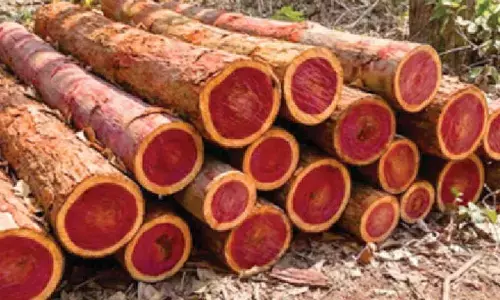CCMB scientists make major breakthrough
 Rakesh Mishra, Director, CCMB, Dr Manjula, Chief Scientist, Manjula Reddy Lab, CCMB, Pavan Kumar Chodisetti, a research student at Manjula Reddy Lab
Rakesh Mishra, Director, CCMB, Dr Manjula, Chief Scientist, Manjula Reddy Lab, CCMB, Pavan Kumar Chodisetti, a research student at Manjula Reddy LabResearchers at Center for Cellular and Molecular Biology (CCMB) proclaimed new discovery on new antimicrobial approaches. They are studying the cell growth in bacteria and have discovered a new enzyme “Murein EndopeptidiaseK” which would cut the bacteria cell wall. The researchers had identified a new enzyme which would act on the protein of cell wall in Escherichia coli (E. coli) that can be a potential drug target.
Hyderabad: Researchers at Center for Cellular and Molecular Biology (CCMB) proclaimed new discovery on new antimicrobial approaches. They are studying the cell growth in bacteria and have discovered a new enzyme "Murein EndopeptidiaseK" which would cut the bacteria cell wall. The researchers had identified a new enzyme which would act on the protein of cell wall in Escherichia coli (E. coli) that can be a potential drug target.
A lot of antibiotics are found in the market to combat with various diseases like cholera typhoid, leprosy and as now there is a growing concern over the bacteria becoming resistant to antibiotics, which means that small infections can also become a threat to a patient. So, to develop the new antibiotic, Manjula Reddy Labs at CCMB discovered a new target that is new enzymes by which cell wall synthesis would not occur.
The man behind this discovery is Pavan Kumar Chodisetti, research student and his mentor Dr Manjula Reddy. The lab of Manjula Reddy explores an altogether different dimension of the synthesis process. By focusing on how the cell governs the synthesis machinery to build the cell wall in the first place, they identified the principal players behind this process and discovered a new mechanism through which the cell regulates growth of its cell wall.
Addressing the media on this event, Dr Manjula, the chief Scientist, Manjula Reddy Lab, CCMB, said that for the past 10 years researchers in her lab were trying to explore new strategies to target bacteria and finally the initial stage has been achieved by discovering the new enzyme. She also said many are resistant to bacteria in general; all the bacterial cell wall is composed of cross link sugar and peptides.
The cell wall communicates the structural integrity and protects the cell wall and its basis for bacteria to grow and proliferates. However, the drug has not been found yet, only the target for the drug has been found that is the new enzymes and next step is to figure out which molecule would bind up with this.
However, the mechanism of cell wall layer growth is unknown. Researchers in the past emphasised much on the process of cell wall synthesis. Accumulation of proteins, each have a different role to constitute complex machinery to incorporate new sugars and peptides as the mesh gradually expands the cells.
In this research, the main focus was on the scissors that change the existing threads in the cell wall to insert new material for the bacterial growth and blocking theses scissors offers new ways to target microbes, said Dr Rakesh Mishra, Director, CCMB. He further said that these findings would be published in the latest issue of Proceedings of National Academy of Sciences journal on Wednesday. Their discovery opens up the possibility for a new class of antibiotics and may play a crucial role in the battle against antimicrobial resistance.














